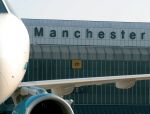
A project to upgrade the air handling units (AHUs) at Manchester Airport with ABB low voltage drives and high efficiency motors is saving 4,000MWh per year, as well as cutting CO2 production by over 2,000 metric tons a year.
The project involved replacing drives and motors in 95 AHUs throughout the airport’s terminals 1, 2 and 3. Each AHU has a supply drive and motor and extract drive and motor, with motors ranging between 3 and 90kW.
Andy Sheridan, Service Facilities Manager for Manchester Airport, says: “The airport has a commitment to achieve carbon neutrality by 2015. Together with our need to reduce costs and our environmental commitments, looking to improve the air handling in the terminals, was an obvious choice.”
The airport already made extensive use of ABB low voltage drives in applications as diverse as baggage handling and pumping. “We generally use ABB drives now across the airport,” says Sheridan. Paul Percy and his team at Massey Coldbeck recommended ABB drives and motors and installed all of the drives for the airport energy saving project, as well as several other projects requiring drives.
Working with Craig Fuller and other members of the ABB Energy Appraisal Team, as well as ABB Drive Alliance member Quantum Controls, Sheridan carried out extensive trials on AHUs 48 and 49, which serve the Terminal 1 check-in hall. Sheridan says: “Terminal 1 is some 50 years old and the normal practice at the time was to oversize motors. By installing the latest ABB IE2 high efficiency motors and resizing them to a more suitable frame size, energy savings of 5% can be realised.”
Monitor savings
The trial also saw ABB standard drives for HVAC installed on the two AHUs. To prove the savings, Manchester Airport’s Engineering Team installed permanent half hourly energy meters and monitored the results over a six month period. By reducing the set point frequency from 50Hz to 40Hz, it was shown that savings of 50% could be made with no noticeable change in the airflows provided by the AHUs.
Calculated annual savings for the high efficiency motors and inverter drive elements of the scheme equate to approximately 4,000MWh. “This saves around 2,200 tons of CO2 a year,” says Sheridan. “We have a target to reduce our CO2 emissions by 27,000 tons a year, so this one application has reduced our emissions by 10% of our target, which for us are very compelling numbers.”
Lower speeds
Another major element of the energy saving project was the use of energy saving dust filters on the AHUs. Says Sheridan: “The filters that we have installed are classed as energy efficient as they maintain the filtering that we get from standard filters but reduce the pressure drop within the units. This ensures we run the supply and extract fans at lower speeds but maintain the same air flow and filtration. We carried out field trials to ensure that the claims of the manufacturer were correct and we did see significant energy savings.”
The ability of the ABB low voltage drives to communicate over BACnet with the airport’s building management system (BMS) will allow the filters to be changed when needed, maintaining their efficiency and contributing to energy saving. A relay is activated when the pressure difference over the supply air filter reaches a pre-set limit. This indicates that the filter has become clogged and requires cleaning or replacement.
